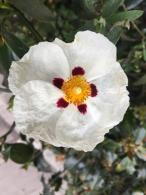Anemone Hybrida Honorine Jobert
Deciduous Low Growing Perennial
1. Add items to basket
2. Go to the basket
3. Enter your postcode in Delivery Price Check
Pot size: 0.5 Litres
Plant ID: 15444 1

Anemone Hybrida Honorine Jobert is a deciduous long flowering Japanese Anemone with pure white petals and yellow stamens. It suits a shady mixed border and holds the RHS AGM.
Despite the name, Japanese anemones are native to China but have naturalized throughout Japan over the centuries and many cultivars have been bred there. Japanese Anemone Honorine Jobert is an old favourite and one of the best white anemones. It was discovered in France in the 1850s and has grown strongly in UK gardens retaining its AGM for decades. This Japanese anemone has long slender stems with dark green deeply divided leaves that appear in mid to late spring. In late summer pure white single flowers with contrasting yellow stamens emerge on stem tips and last for weeks into autumn.
This is an undemanding, pretty perennial that creates colour in a garden that is starting to fade for winter.
Height And Spread of Anemone Hybrida Honorine Jobert
Much taller than our native woodland anemone, Japanese Anemone Honorine Jobert will reach a height and spread of a metre.
How Hardy Is Anemone Hybrida Honorine Jobert
Fully hardy in UK winters if its roots are well-drained, Honorine Jobert is a proven Japanese anemone that comes back better each year.
How To Use Anemone Hybrida Honorine Jobert
This is a lovely choice for informal gardens and country-style flower borders. It will tolerate coastal sprays and attracts insects with its late-blooming flowers.
Use it in a mid-border spot to create height and clean white colour in late summer to early autumn. Once established it can spread, so give it plenty of room to grow as it dislikes being moved.
How To Care For Anemone Hybrida Honorine Jobert
This anemone needs a partially shady spot and dislikes too much heat. Choose a well-drained position with shade from excessive sun and water well in hot spells.
It is not fussy about soil type and will grow in chalk or sandy soils if they are well-drained.
Cut back spent foliage during late autumn and mulch in autumn to provide nutrients for the coming year and protect its roots from winter rain.












